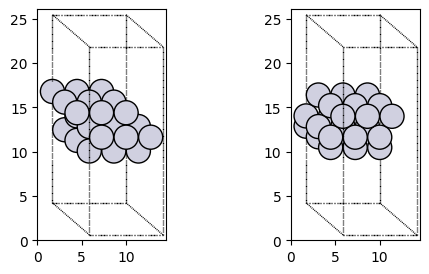6.3. Adsorption energy from DFT#
6.3.1. Adsorption Energy#
Adsorption energy refers to the change of energy when an adsorbate is attached to the surface of an adsorbent.
Adsorption energy, \({\Delta}E_{a}\), can be obtained by calculating the difference between the energy of the adsorbed surface and the sum of the energy for each structure composing the adsorbed surface:
\({\Delta}E_{a} = E_{ads,slab} - E_{slab} - E_{ads}\)
6.3.2. Calculating Adsorption Energy in SPARC#
Consider O2 adsorption on Platinum (Pt) surface with constrained atom positions. For this situation, we will first build the Atoms object for Platinum slab and adsorb an oxygen molecule to the slab.
Building atoms
In the following script, a Pt slab is created. The bottom two layers of Pt (in z-direction) are fixed. The exact position to divide the atoms is determined by visualizing the ‘input.traj’ file with ase gui command. By clicking on the atoms in the pop-out window, the exact position within a cell will be displayed. After applying the constraint to the system, visualizing ‘input.traj’ file with ase gui command, you should be able to see the bottom two layers of Pt atoms have a cross on them, indicating that they are fixed. Another way to check or to manipulate the constraint is by ‘POSCAR’, where it lists the positions and constraints of all atoms in the system.
from ase.build import bulk, molecule, surface, add_adsorbate, fcc111, fcc100
from ase.constraints import FixAtoms
from ase.io import read
#building Platinum slab
bulk = bulk('Pt')
miller_indices = (1, 1, 1)
layers = 3
slab = surface (bulk , indices = miller_indices , layers = layers , vacuum =10)
slab = slab.repeat((1,1,1))
c = FixAtoms ( indices = [ atom.index for atom in slab if atom.position [2] <14 ]) #constrained atoms (fixing the bottom 2 layers)
slab.set_constraint(c)
slab.write('slab.traj')
There is another way to generate surfaces.
import matplotlib.pyplot as plt
import numpy as np
from ase.visualize.plot import plot_atoms
slab_fcc111 = fcc111('Pt', size=(1,1,3), vacuum=10)
fig, axs = plt.subplots(1, 2, figsize=(6, 3))
plot_atoms(slab.repeat([3,3,1]), axs[0], rotation=('120x,0y,0z'))
plot_atoms(slab_fcc111.repeat([3,3,1]), axs[1], rotation=('120x,0y,0z'))
slab.write('POSCAR_1')
slab_fcc111.write('POSCAR_2')
if np.all(slab.get_all_distances(mic=True) == slab_fcc111.get_all_distances(mic=True)):
print("Two surfaces are identical.")
Two surfaces are identical.

Build an O2 molecule with ase library.
from ase.build import molecule, bulk
import numpy as np
from shutil import copy
import os
#building oxygen molecule
atoms = molecule('O2')
max_pos = np.amax(atoms.get_positions(), axis=0)
atoms.set_cell(np.array([10, 10, 10]) + max_pos)
atoms.center()
atoms.write('O2.traj')
Attach the O2 to the Pt slab using ase.build.add_adsorbate().
from ase.build import bulk, molecule, surface, add_adsorbate
from ase.constraints import FixAtoms
from ase.io import read
slab = read('slab.traj')
adsorbate = molecule('O2')
add_adsorbate(slab, adsorbate, height = 2.5, position = (1.386, 0.800) )
c = FixAtoms ( indices = [ atom.index for atom in slab if atom.position [2] <14 ]) #constrained atoms (fixing the bottom 2 layers)
slab.set_constraint(c)
slab.write('slab_ads.traj')
DFT calculation
In the following script, we define a SPARC calculator object and attach it to an ase.Atoms object so that ase knows how to get the data. After defining the calculator, a DFT calculation can be run. The potential energy can be obtained by the method: get_potential_energy(). The potential energy result can be stored in a text file e.g. ‘energy.txt’.
Details on how to submit these calculations can be seen in Lecture ‘Running_SPARC_on_PACE’.
Clean slab calculation
from ase.io import read
from ase.optimize import BFGSLineSearch
from ase.units import Bohr,Hartree,mol,kcal,kJ,eV
from sparc import SPARC
import numpy as np
image = read('slab.traj')
# Setting up calculator.
# Here, we set relatively low values for KPOINT_GRID and ECUT, and did not apply spin-polarization
# so that we can finish the calculations faster. This can lead to unreasonable energy values.
parameters = dict(
EXCHANGE_CORRELATION = 'GGA_PBE',
D3_FLAG=1, #Grimme D3 dispersion correction
SPIN_TYP=0, #non spin-polarized calculation
KPOINT_GRID=[2,2,1], #slab needs only 1 kpt in z-direction
ECUT=500/Hartree, #set ECUT (Hartree) or h (Angstrom)
#h = 0.15,
TOL_SCF=1e-4,
RELAX_FLAG=1, #Do structural relaxation (only atomic positions)
TOL_RELAX = 1.00E-03, #convergence criteria (maximum force) (Ha/Bohr)
PRINT_FORCES=1,
PRINT_RELAXOUT=1)
parameters['directory'] = 'slab'
calc = SPARC(atoms = image, **parameters)
image.set_calculator(calc)
eng = image.get_potential_energy()
image.write('converged_slab.traj')
with open('slab_energy.txt', 'w') as f:
f.write(str(eng))
Step 0
Step 1
Step 2
Step 3
Step 4
Step 5
{0: array([False, False, False]), 1: array([False, False, False]), 2: array([ True, True, True])}
[0, 1, 2] [0, 1, 2]
O2 on the Pt slab
from ase.io import read
from ase.optimize import BFGSLineSearch
from ase.units import Bohr,Hartree,mol,kcal,kJ,eV
from sparc import SPARC
import numpy as np
image = read('slab_ads.traj')
# setup calculator
parameters = dict(
EXCHANGE_CORRELATION = 'GGA_PBE',
D3_FLAG=1, #Grimme D3 dispersion correction
SPIN_TYP=0, #non spin-polarized calculation
KPOINT_GRID=[2,2,1], #slab needs only 1 kpt in z-direction
ECUT=500/Hartree, #set ECUT (Hartree) or h (Angstrom)
#h = 0.15,
TOL_SCF=1e-4,
RELAX_FLAG=1, #Do structural relaxation (only atomic positions)
TOL_RELAX = 1.00E-03, #convergence criteria (maximum force) (Ha/Bohr)
PRINT_FORCES=1,
PRINT_RELAXOUT=1)
parameters['directory'] = 'slab_ads'
calc = SPARC(atoms = image, **parameters)
image.set_calculator(calc)
eng = image.get_potential_energy()
image.write('converged_slab_ads.traj')
with open('slab_ads_energy.txt', 'w') as f:
f.write(str(eng))
Step 0
Step 1
Step 2
Step 3
Step 4
Step 5
Step 6
Step 7
Step 8
Step 9
Step 10
Step 11
Step 12
Step 13
Step 14
Step 15
Step 16
Step 17
Step 18
Step 19
Step 20
Step 21
Step 22
Step 23
Step 24
Step 25
Step 26
Step 27
Step 28
Step 29
Step 30
Step 31
Step 32
Step 33
Step 34
Step 35
Step 36
Step 37
Step 38
Step 39
Step 40
Step 41
Step 42
Step 43
Step 44
Step 45
Step 46
Step 47
Step 48
Step 49
{0: array([ True, True, True]), 1: array([ True, True, True]), 2: array([False, False, False]), 3: array([False, False, False]), 4: array([ True, True, True])}
[2, 3, 4, 0, 1] [3, 4, 0, 1, 2]
O2 gas reference energy calculation
from ase.io import read
from ase.optimize import BFGSLineSearch
from ase.units import Bohr,Hartree,mol,kcal,kJ,eV
from sparc import SPARC
import numpy as np
image = read('O2.traj')
# setup calculator
parameters = dict(
EXCHANGE_CORRELATION = 'GGA_PBE',
D3_FLAG=1, #Grimme D3 dispersion correction
SPIN_TYP=0, #non spin-polarized calculation
KPOINT_GRID=[1,1,1], #molecule needs single kpt !
ECUT=500/Hartree, #set ECUT (Hartree) or h (Angstrom)
#h = 0.15,
TOL_SCF=1e-4,
RELAX_FLAG=1, #Do structural relaxation (only atomic positions)
TOL_RELAX = 1.00E-03, #convergence criteria (maximum force) (Ha/Bohr)
PRINT_FORCES=1,
PRINT_RELAXOUT=1)
parameters['directory'] = 'O2'
calc = SPARC(atoms = image, **parameters)
image.set_calculator(calc)
eng = image.get_potential_energy()
image.write('converged_O2.traj')
with open('O2_energy.txt', 'w') as f:
f.write(str(eng))
Step 0
Step 1
Step 2
Step 3
{}
[0, 1] [0, 1]
Analysis of adsorption energies
import os
from ase.io import read
def readFile(path):
f = open(path, 'r')
content = f.readlines()
return content
def read_energy(path):
energy = float(readFile(path)[0])
return energy
E_slab = read_energy('slab_energy.txt')
E_slab_ads = read_energy('slab_ads_energy.txt')
E_O2 = read_energy('O2_energy.txt')
# E_adsorption is the adsorption energy
E_adsorption = E_slab_ads - E_slab - E_O2
print('The adsorption energy of O2 on Pt slab is {0:1.3f} eV'.format(E_adsorption))
The adsorption energy of O2 on Pt slab is -0.831 eV
